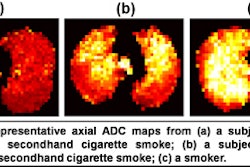CHICAGO - The practice of medicine has always been shaped by turf battles, and the current conflict over physician self-referral -- in both the local practice and the federal government arenas -- is the latest thorny issue for radiologists. Two studies presented Monday at the 2007 RSNA meeting explored the problem.
Which specialists are self-referring the most? Dr. Vijay Rao, chair of the department of radiology at Thomas Jefferson University in Philadelphia, and colleagues investigated overall changes in the utilization rates of noninvasive diagnostic imaging (NDI), as well as which medical specialties are most active in NDI, and presented their findings at the RSNA conference.
For its study, the group used the Medicare Physician/Supplier Procedure Summary Master Files for 2000 through 2005, which contain volumes for all procedures by physician specialty. They calculated utilization rates per 1,000 patients for the approximately 500 procedure codes that make up NDI, excluding claims from independent diagnostic testing facilities (IDTFs) and multispecialty groups (3% of the total).
What they found is that overall Medicare NDI utilization rate per 1,000 increased by 25%, from 3,268 occurrences in the year 2000 to 4,084 in 2005.
"In the late 1990s, the trend line (for utilization rates) was relatively flat," Rao said. "Around the year 2000, we start seeing an uptrend in the use of noninvasive diagnostic imaging services."
NDI utilization rate increases among radiologists, primary care physicians, orthopedic surgeons, and other physicians landed within a 22% to 27% range:
- Radiologists: 22%
- Primary care physicians 22%
- Orthopedic surgeons: 24%
- All other physicians: 27%
But cardiologists' rate of NDI utilization increased three times as much as these other groups, from 415 occurrences in the year 2000 to 687 in 2005, for an increase of 65%, leading Rao and colleagues to conclude that although nonradiologist physicians are self-referring, cardiologists are the most active in doing so.
Rao also outlined the utilization growth rate for the time period for individual modalities used by radiologists. Plain film and mammography are the most used modalities, but had modest growth of 9%. High-end modalities such as CT showed 69% growth, ultrasound had 30% growth, and PET had growth of 17%. MRI showed substantial growth, at 82% over five years, although its overall use is much lower than CT, according to Rao.
In all, Medicare Part B payments for NDI increased by 93%, from $6 billion in 2000 to almost $12 billion in 2005, she said.
MSK MRI
In a related presentation from a study conducted at the Center for Research on Utilization of Imaging Services (CRUISE), also in the department of radiology at Thomas Jefferson University, Dr. David C. Levin and colleagues evaluated the use rate of musculoskeletal MRI performed in private offices on units owned by orthopedic surgeons (the study did not include data about musculoskeletal MRIs performed in an outpatient hospital environment).
Using the same database from Medicare that Rao's group used, Levin's team extracted procedure volumes in private offices for each MSK MRI CPT-4 code with Medicare's place-of-service codes. The group used Medicare's physician specialty codes to determine the specialty of the physician who was the owner or lessor of the equipment on which the scan was performed.
Much to RSNA attendees' chagrin, Levin and his group found a 139% growth in private office MSK MRI exams, from 707,603 in the year 2000 to 1,689,154 in 2005, with orthopods far outstripping radiologists, IDTFs, and other physicians in utilization. In 2005, of all the Medicare MRI exams performed by orthopedic surgeons in their offices, 96% were MSK, either spine or extremities; Medicare paid orthopedic surgeons $77,046,449 for these studies, Levin found.
"There's a lot of money at stake here," he said.
But despite these statistics, radiologists still performed the majority of office MSK MRI studies in 2005, at 924,714 occurrences as compared to the following:
- IDTFs: 471,174
- Orthopods: 155,301
- Other clinicians: 137,965
Orthopedic surgeons' share in the pie was small, at 9%. However, ownership or leasing of MRI facilities by orthopedic surgeons was growing by 400%, much faster than by radiologists at about 100%. How much these percentages will be affected by the Deficit Reduction Act (DRA) of 2005 remains to be seen, Levin said.
By Kate Madden Yee
AuntMinnie.com staff writer
November 26, 2007
Related Reading
CMS to delay portion of Stark III, November 20, 2007
Same-specialty referring physicians use imaging more frequently, study says, November 8, 2007
CMS delays in-office self-referral decision with new MPFS rule, November 7, 2007
Maryland court backs state's self-referral law, October 26, 2007
Imaging self-referral comes under scrutiny in California, April 20, 2007
Copyright © 2007 AuntMinnie.com







